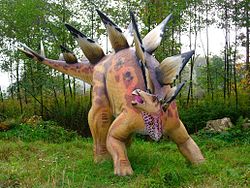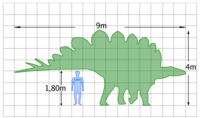|
Vikidia currently has 4,625 articles. Improve it! |
|
Join Vikidia: create your account now and improve it! |
Stegosaurus

Stegosaurus was a type of dinosaur. They had bone plates standing up on their backs. These special plates make them one of the most well-known dinosaurs. Stegosaurus was a herbivore, so they only ate plants. They lived in what is now western North America.
Stegosaurus lived in the Upper Jurassic time period. This was about 155 to 145 million years ago. Stegosaurus is Greek for "plated lizard." This name is given to Stegosaurus because it has many heavy armour of plates on its back. The stegosaurus is also famous for being a dumb dinosaur, because it had a small brain, compared to its large body.
Description[edit | edit source]
Stegosaurus was the largest stegosaur, reaching up to 12 m in length and weighing up to 5,000 kg. However, 7 to 9 m was a more usual length. Stegosaurus's front feet each had five toes and there were three toes on each back foot. The feet resembled gigantic horse hoofs and the people who first discovered them actually thought they might have come from giant horses.
This double row of kite-shaped plates on its back, and the long spikes on its tail make it easily recognized.
Nobody knows for sure what the back plates were used for, but many scientists now believe that they were used for temperature control – to gather heat from the surroundings. They would have been used like solar panels. When the animal needed to warm up, it would stand with its side toward the sun. The thin skin and many blood vessels covering the plates would soak up the heat of the sun. When the Stegosaurus got too hot, it could stand in the shade, or turn itself to face the sun (or face away from it). Then the blood vessels could be cooled.
For defence Stegosaurus did have four (or eight) heavy spikes on its tail, which could be used to hit attackers. It was probably necessary as it lived with such meat-eaters as Allosaurus and Ceratosaurus.
Stegosaurus's mouth was shaped a bit like a beak and had no teeth in the front – probably for snipping plants.
Skull[edit | edit source]
The skull of Stegosaurus was long and narrow. Because of its short front legs, its head was close to the ground, probably no higher than 1 m. It ate low-growing plants because of this. It had no front teeth, but it did have a horn-covered beak. Stegosaurian chewing teeth were small and triangular and did little grinding as they lacked wear surfaces.[1]
Unlike most dinosaurs, it did not have a hole in its skull between its nose and eye (lacuna) between the nose and eye.[2]
Nervous system[edit | edit source]
It has often been said that the Stegosaurus brain was the size of a walnut. Actually, it had a brain several times the size of a walnut. The bundle of nerves near the base of the tail that controlled reflexes in the back of the body was larger than the brain and is sometimes said to be a "second brain".
Posture[edit | edit source]
Stegosaurus had very short forelimbs in relation to its hind legs. The back legs each had three short toes, while the front legs had five toes. All four limbs were supported by pads behind the toes.[2]
| Stegosaurus Temporal range: Upper Jurassic, 155 – 145 mya | |
|---|---|

| |
| Model Stegosaurus, Bałtów Jurassic Park, Poland. | |
| Scientific classification | |
| Kingdom: | Animalia |
| Phylum: | Chordata |
| Class: | Sauropsida |
| Superorder: | Dinosauria |
| Order: | Ornithischia |
| Suborder: | Thyreophora |
| Infraorder: | Stegosauria |
| Family: | Stegosauridae |
| Genus: | Stegosaurus Marsh, 1877 |
Feeding[edit | edit source]
Stegosaurus was a herbivore, meaning it ate plants. It mainly liked to browse plants near the ground, because they were the easiest to reach with its short neck. They were plants such as ferns, mosses, cycads and baby evergreen trees, which contained little nutrition. Stegosaurus may have been able to rear up on its hind legs for short periods of time to browse plants that were otherwise out of reach.
Due to plants having little nutrition in each bite, the Stegosaurus had to eat a lot. It would spend most of its day eating.
Discovery and species[edit | edit source]
Stegosaurus was originally named by Othniel Charles Marsh in 1877[3], from fossils found near Morrison, Colorado. These first bones became the first species of Stegosaur named: Stegosaurus armatus.
Several different Stegosaurus species have been found.
- Stegosaurus armatus: This was the first type of Stegosaurus to be found. Over thirty different skeletons have been discovered by scientists. This type had four tail spikes and small plates. At 9 meters, it was the longest species of Stegosaurus.
- Stegosaurus stenops: Named by Marsh in 1887,[4] it was discovered near Cañon City, Colorado, in 1886. This is the best known species of Stegosaurus, mainly because its fossils make at least one complete skeleton. It had large, broad plates and four tail spikes. S. stenops is known from at least 50 partial skeletons of both adults and juveniles, one complete skull and four partial skulls. It was shorter than S. armatus, at 7 m.
- Stegosaurus longispinus: This type of Stegosaur is known from one incomplete skeleton. S. longispinus had a set of very long tail spines. Like S. stenops, it grew to 7 m in length.
- S. ungulatus: Named by Marsh in 1879 from remains recovered at Como Bluff, Wyoming,[5] it is only known from a few backbones and armor plates. It is probably the same as S. armatus.
- S. sulcatus: This is another partial skeleton. It is probably the same as S. armatus.
- S. duplex: This animal is probably the same as S. armatus. It was also named by Marsh in 1887,[4]. Its fossils were found in 1879 by Edward Ashley at Como Bluff, Wyoming.
- ?S. seeleyanus: Probably the same as S. armatus.
- ?S. (Diracodon) laticeps: Named by Marsh in 1881 from some jawbone fragments.[6].
The most complete Stegosaurus fossil ever found was nicknamed "Spike". It was discovered in Colorado, USA, by Bryan Small, Tim Seeber and Kenneth Carpenter in 1992.
Classification[edit | edit source]
Stegosaurus was a member of the Thyreophora, or armored dinosaurs, a family of dinosaurs which includes the ankylosaurs.
Where did they live?[edit | edit source]
They lived in subtropical parts in the USA, but there were also stegosaurus living in other parts of the world including Africa, China, Mongolia and Europe.
Stegosaurus fossils have been found in the US states of Colorado, Utah and Wyoming.
Popular culture[edit | edit source]
Stegosaurus has been declared the State Dinosaur of Colorado. It has also appeared in many movies and TV shows.
Footnotes[edit | edit source]
- ↑ Fastovsky DE, Weishampel DB (2005). "Stegosauria:Hot Plates". In Fastovsky DE, Weishampel DB. The Evolution and Extinction of the Dinosaurs (2nd Edition). Cambridge University Press. pp. 107 – 130. ISBN 0521811724.
- ↑ 2.0 2.1 Lambert D (1993). The Ultimate Dinosaur Book. Dorling Kindersley, New York. pp. 110-129. ISBN 156458304X.
- ↑ Marsh OC (1877). "A new order of extinct Reptilia (Stegosauria) from the Jurassic of the Rocky Mountains". American Journal of Science 3 (14): 513 – 514.
- ↑ 4.0 4.1 Marsh OC (1887). "Principal characters of American Jurassic dinosaurs, part IX. The skull and dermal armour of Stegosaurus". American Journal of Science 3 (34): 413 – 417.
- ↑ Marsh OC (1879). "Notice of new Jurassic reptiles". American Journal of Science 3 (18): 501-505.
- ↑ Marsh OC (1881). "Principal characters of American Jurassic dinosaurs, part V". American Journal of Science 3 (21): 417 – 423.
Other websites[edit | edit source]
- Dinopedia [1]
- Stegosaurus "roofed lizard", by T. Mike Keesey at The Dinosauricon.


